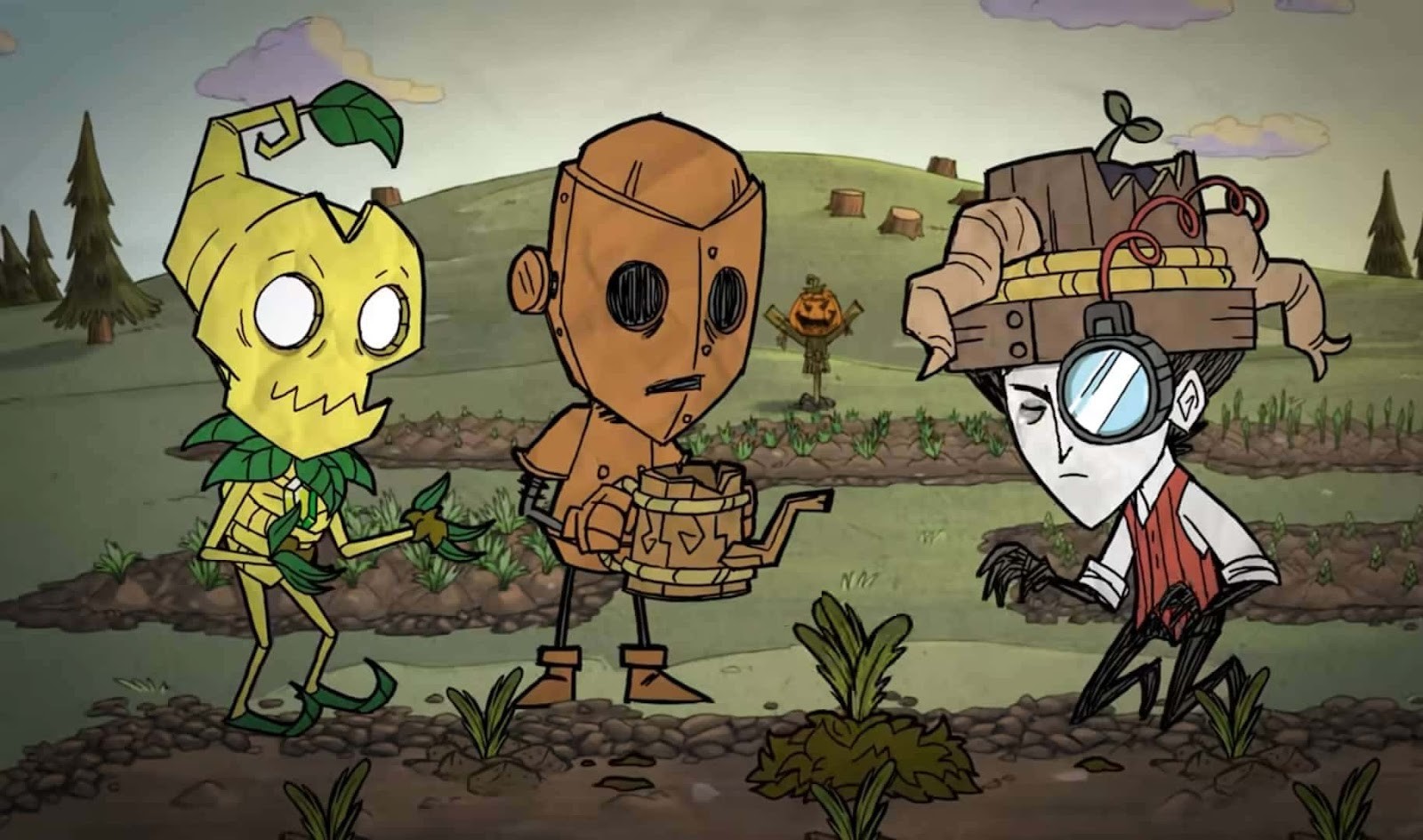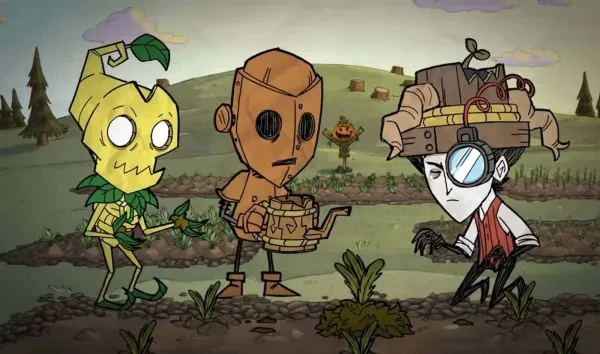
While exploration and farming resources are pertinent in regards to prolonging your extended survival, the place where you choose to call home can make or break any Don’t Starve game. There is no definitive ‘correct’ answer as to where to plonk your base, as each of the different parts of the map all have their own perks and hardships - but some areas are certainly more practical than others.
In its entirety, the Don’t Starve map almost resembles a giant jigsaw puzzle, with each of the different areas and terrains (referred to as biomes) connecting up with the next to form one great landmass. Different biomes are known for their different features and characteristics; the specifics of which differ from game to game but the fundamentals remain consistent.
To be more specific, there are particular resources, set-pieces, entities and things that can be very beneficial to have within a stones-throw of your settlement. Due to the random nature of your spawn world, it is not always possible to camp nearby all of these, making it sometimes a little difficult to pick which ones you’re going to commit to. This article will seek to breakdown all of these specific requirements for you, and rank them in order of their convenience.
For this article, I will only be exclusively referring to biomes from the base game, and the supplementary ones added in the Reign of Giants expansion. Furthermore, while it would technically be possible to base in them, I also shan’t be mentioning any areas which are found below ground level, such as cave and ruin biomes.
10. Chess.
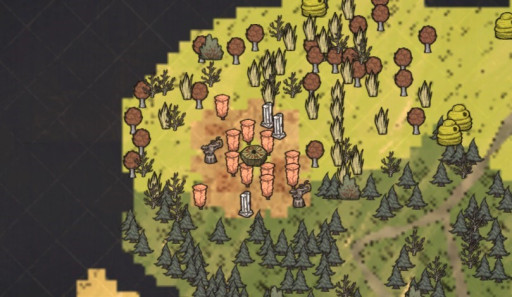
Forget what you know about the board game, because chess biomes don’t always play by the rules.
By far the smallest of the biomes, we start this list with the strangle little areas known as chess. On the surface, these places may look hostile and uninviting, but looks can be deceiving as this doesn’t stop them from possessing their own merit. Setting up a base nearby can be beneficial for the player in ways which might not be immediately apparent.
Chess biomes are almost always populated by entities known as the clockwork creatures. Resembling anthropomorphic chess pieces, these things are highly aggressive, dealing large amounts of damage and attacking you on sight. So why would you want to live near them, you might ask? This question has several answers…
First of all, these mechanical creatures offer great protection from other hazardous mobs, such as the infamous hound attacks. It is fairly easy to distract them with these other enemies too, leaving you safe to go about your day as usual. Clockwork creatures will drop gears upon their own demise too, which are an incredibly valuable item - especially for WX-78 players.
As well as this, the chess biome has some great resources, such as marble trees. This gives players easy access to useful items which can otherwise be tricker to come by. Just make sure that you don’t base yourself too close by, or else you could be at danger of an unwanted surprise visit.
9. Forest

Sheltering under a cluster of trees can protect you from the rain - as long as you don’t chop them down.
Forest biomes are primarily characterised by their dense abundance of trees. This can be incredibly useful for players who are just starting out, as wood is a vital ingredient in crafting most essential items. Providing that you plant a new tree for every one that you chop down, camping out in a forest can be a great way to access an almost endless supply of wood.
Forests also contain a decent ratio of twigs and berry bushes, which honestly you can never have too many of. By having them already growing in close proximity to your camp, you will never have to worry about running out. Grass can be a little more difficult to come by, but as you can easily uproot the tufts and relocate them elsewhere, this shouldn't exactly be a dealbreaker for you.
Unfortunately, forests can be easily susceptible to forest fires, due to the trees flammable properties and the way in which fire spreads. While this is great for obtaining charcoal, it does mean that you’ll have to be very careful ensuring that these fires do not eliminate your supply of wood - and of course your base itself. Forest dwelling players will have to ensure that they have an adequate number of lightning rods dotted around their habitat to counterbalance this.
As well as this, food can be a little scarce in forested areas. Don’t get me wrong; the abundance of berry bushes is a huge bonus, but they are not the most efficient source of food. Outside of these, forests are unlikely to offer you much in the way of any other easily renewable ingredients.
8. Rockyland

If Stone-Age technology is your thing, then you’ll feel right at home in the rockyland.
Next on this list, we have the rockyland regions, which are recognised by their rough stone flooring and their plentiful rocks and boulders. As no other biomes can guarantee the latter in such a concentrated quantity, rock biomes can be a great place for players if they envisage themselves living in a sturdy and fortified home. Stone walls are easily the most effective barrier against mobs, meaning that those who settle in the rockylands will enjoy the luxury of almost impenetrable bases.
As well as this, the likelihood of striking gold in these biomes is statistically much higher - quite literally! As gold is an essential resource to progress through the game (as well as being an important component of all of the more science based gear), this is a benefit that cannot be ignored.
Despite this, the hard rocky flooring found in these areas eliminates your ability to plant things. As trees, grass, twigs and all of your other essential botanicals will refuse to grow in this biome, it can be difficult to set up functional farms. While it is technically possible to relocate more arable turf to allow for easier planting, this still poses an additional (and arguably, unnecessary) challenge.
The notorious tallbirds also typically dwell in these areas, which can be a real nuisance to players who aren’t completely prepared to face them. Fiercely protective of their eggs and their young, these giant flightless avians will aggressively pursue you for considerable distances across the map if they deem you to be an immediate threat. On the flip side, however, this does open up the opportunity to access a steady supply of meat - if you are capable of taking them on.
7. Graveyard
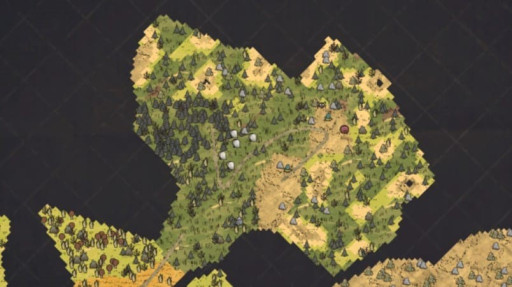
You’ll know you’ve stepped foot in a graveyard biome once a thin mist starts to engulf your screen.
If you are willing to overlook the overall eerie feeling, the graveyard biome can make a great place to call home. These areas are (perhaps unsurprisingly) littered with a number of tombstones and crude burial sites, which the more nefarious amongst us are more than welcome to go poking around in. While each grave robbed will cost the offending player ten points of their sanity, they can also contain some cool buried treasures, including unique and difficult to obtain items.
Make sure you bear in mind however that the robbing of graves is a one-shot type of deal; once one has been dug up once, it can’t ever be dug again. This leaves the longevity of graveyard basing up for debate.
Nevertheless, it is not uncommon to find nuggets of gold scattered between the graves, as well as other handy items such as twigs, trees and rocks. As was previously mentioned in the rockyland section, gold is an invaluable resource and easy access to it is an undeniable bonus. There is nothing stopping you from simply picking it all up and taking it with you elsewhere though.
Another thing to remember about the graveyard biomes is that they are technically haunted. Once a full moon, the spirits of the deceased will emerge from their burial sights with a vengeance, looking to attack anything and everything that comes into their path. Unfortunately, this includes you too.
6. Desert
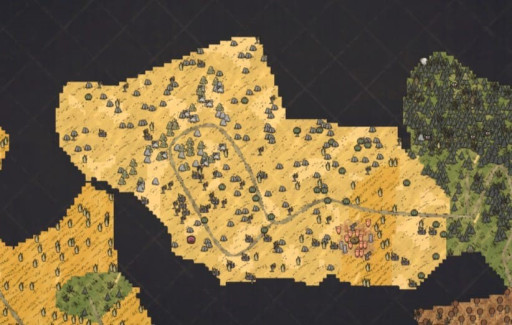
Be sure to pack a bottle of sun-cream if you decide to set up base in the desert.
The word desert is not often associated with the idea of habitable land, so you may well be surprised to learn that basing in one is not a bad idea by any means. For one, desert biomes have some pretty unique properties that you won’t be able to find anywhere else, such as the cactus plant, vultures and volt goats. This is great because it means that you won’t have to waste time harvesting them, as it is not possible to relocate a lot of these features.
As cactus plants provide essential materials to survive the summer, and volt goats are a steady supply of food and weaponry, you’re really not going to want to be too far away from the desert. And as the case may be, this is just as well…
Unlike most of the other biomes, generated Don’t Starve worlds will often only spawn one deserted area, which is usually fairly large and located in a more isolated part of the map. This can make them a little trickier to get to than other biomes, with the possibility of backing yourself into a corner. By placing your camp inside of one, you therefore minimise your commute.
The main benefit of hunkering down in a desert however is the prevalence of tumbleweeds. While it's true that it is possible to find tumbleweeds bouncing around other portions of the map, nowhere will contain as many as the desert. These are incredibly useful as they provide an infinite source of twigs, grass and other special items - even during the wintertime when crops won’t grow.
Make sure you listen out for baying barks and growls, however, as deserts are the only biomes to contain set pieces known as hound mounds. Resembling a stack of bones, these will spawn a pack of the pesky beasts whenever you come too close to one. As hound waves can pose a formidable threat to the player, the possibility of dramatically increased hound populations is really not ideal.
5. Grasslands

There’s something quite idyllic about these rich and fertile lands.
The grasslands are generally quite a safe area to find oneself in, as denoted by their lush green flooring and their abundance of pretty flowers. There are also plenty of potential food options coming out of the grassland, such as beehives and mole mounds. The flowers will also spawn a significant number of butterflies, which are not only great for healing but also can be planted to make new flowers.
Flowers are also essential for the bees to pollinate and produce honey, which can be processed via beeboxes. While the act of building and using a box will aggravate said bees, these mobs do low amounts of damage and are fairly easy to kill, even in swarms. Just watch out for the significantly more aggressive red bees, who offer players little benefit and will attack on sight.
Despite their abundance of food, grasslands can often be a bit of a mixed bag. Some of the time, they will be absolutely littered with grass, twigs, bushes and trees, while other times they can be a little bit empty and barren - it really is a gamble. Fortunately, there will more often than not be several of them dotted throughout the game world.
The main thing to watch for is the dreaded walrus camps, which are most likely to appear in these areas. While harmless most of the year, during the winter time they spawn an enemy known as MacTusk, who can be a challenge to deal with. Whatever you do, make sure you base your camp nowhere near his dwelling.
4. Mosaic
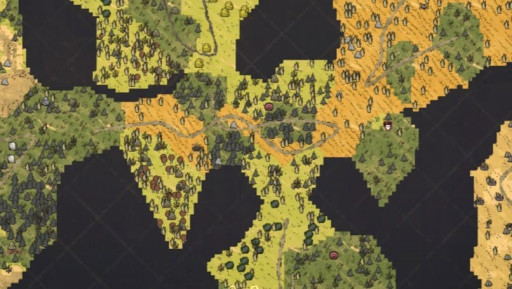
Fancy a little slice of everything? Sounds like the mosaic biome is the one for you.
The mosaic biome is an interesting addition to this list, as it is composed of much smaller versions of all of the rest of the biomes sandwiched tightly together as one - much like a mosaic. While offering nothing new or unique to the table per say, it negates the need to pick one biome over another. As all of the different areas found across the Don’t Starve map each have their own benefits, a homage of all of the best bits is difficult to overlook.
Although it contains nothing in abundance, a mosaic biome has a little bit of everything to offer, all conveniently condensed to a much more manageable area. Whether you value stones, trees, berry bushes or twigs; the mosaic biome has it all.
That being said, a downside to this is that they do have a tendency to omit some of the more specialised set pieces. This means that although you might have a grassland section for example, it will probably be missing its signature beehives. This can prove to be a little frustrating, bringing to mind the phrase: “a jack of all trades, but a master of none”.
As well as this, the fragmented nature of this biome means that it has a tendency to spawn lakes. These are not the fishing kind either, but more like the inland variants of the impenetrable edges of the game map. While not a problem exactly, this can make mosaics extremely annoying to traverse, by forcing you to take unnecessary detours around these lakes.
3. Marsh
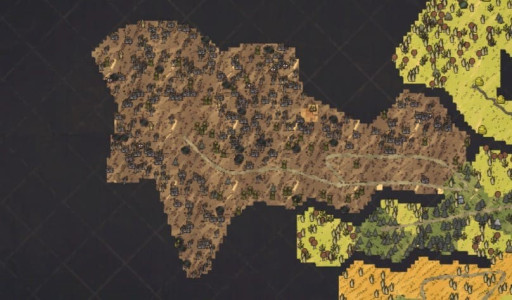
While the marshland may look intimidating, don’t let the potential threats put you off.
Although arguably one of the game's more hostile biomes, marshlands can be utilised as very efficient places to set up camp if you are willing to adapt your playstyle around its dangers. The main glaringly obvious hazard is the unmapped tentacles, which will shoot out of the ground to deal large amounts of damage to any unsuspecting players who venture too close. Mapping these out can be challenging, but not impossible and well worth your time and effort if you do so.
The benefit of the marshlands is that they are the only place you will find reeds, an incredibly valuable resource that the game makes impossible to uproot. In lieu of bringing them closer to you, it therefore makes a lot more sense to merely place your base closer to them.
Ponds are also commonly found in these swamp-like regions, but unlike the mosaic’s lakes, these ones can be fished in. This can offer players a near infinite source of seafood.
Another huge plus to this biome is that it is home to other helpful mobs. While technically hostile in their own right, spiders, merms, mosquitos and even pigs are all known to congregate in these areas, which means that they are just as likely to be picking fights with each other as they are with yourself. As all of these creatures drop food items upon their demise, you can reap all of the benefits and never worry about foraging for food again - as long as you can avoid being dragged into the battle yourself.
2. Decidueous Forest
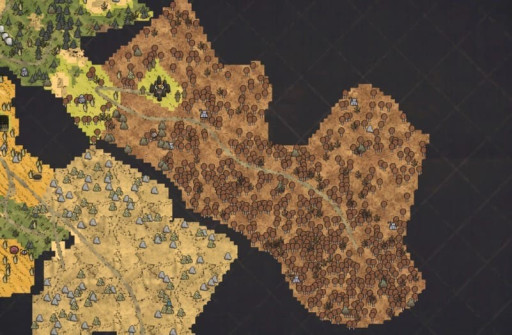
If you like the idea of forest, but think that it could do with being a little more deciduous, then look no further.
Far superior to its aforementioned name sake, the deciduous forest is one of the best areas in the game to build yourself a base. These areas are generally always teeming with life, which is a great opportunity for easy food. Unlike the marshlands, most of the creatures found here - such as pigs, catcoons and mole worms - are neutral to your presence, meaning they will only bother you if you bother them.
Deciduous forests seem to be the pigmen’s favourite biome to inhabit too. Generally speaking, if you are going to stumble across a semi-autonomous pig village (or better still, the pig king), it will be in this biome. Pigs make great allies due to their willingness to fight and the ease at which you can befriend them; the pig king is an even better ally as you can trade with him junk for gold.
That’s not all either, as come nighttime the deciduous forest also boasts a large abundance of fireflies. While you can’t straight-up eat these guys, fireflies are essential for building and refuelling the miners hat, which allows you to see in the dark. As your time is precious in Don’t Starve, freeing up more time to complete tasks is of paramount importance, and the untapped supply of firefires to be caught in these forests is a useful addition.
As well as boasting all the regular essential items, deciduous forests also house a special variety of tree, known as the birchnut. The seeds used to plant more of these trees are edible when roasted, meaning that you will naturally acquire a small food reserve simply by playing the game. They can also be combined with wild berries to create a fantastic source of healing, in the form of trail mix.
1. Savannah
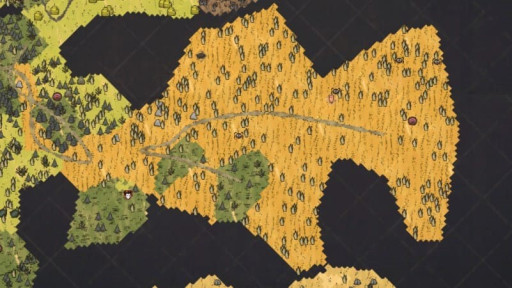
The savannah is the undisputed champion when it comes to looking for a biome to live in.
The absolute best spot to set up your camp is without a doubt the savannah biome. While this dusty landmass might appear on the surface to be a little sparse, empty and barren, upon further inspection it becomes quickly apparent that it provides absolutely everything needed to set up a great base. Once you have all of the core basics built, you in theory might never have to leave the comfort of the savannah again.
The main selling point that the savannah has to offer is its wealth of rabbits. As traps are incredibly easy to both build and place on top of rabbit holes, you can guarantee a constant and renewable supply of meat to keep your belly full. In fact, you will likely end up with so much meat that you will have to turn the excess into jerky, to stop it from spoiling before you get a chance to actually eat it.
As if this wasn’t enough, savannah’s are a great place to bump into a herd of Beefalo. And make sure you make a note of it if you do, as beefalo are an essential component of farming. Beefalo manure is required not only to build the farms themselves, but also to fertilise the crops that grow, meaning that having a herd nearby will save you a great deal of time and effort.
While it is true that the savannah’s materials consist mostly of grass, the odd rock and not a lot else, this is actually not too much of a problem. On the contrary, it can be very convenient to base yourself in a sprouting patch of grass. This is because twigs are much easier to reallocate than grass is; the former not requiring any sort of fertiliser to grow again after they've been uprooted. It therefore makes a lot more sense to bring twigs to an already grassy area, rather than the other way around.

